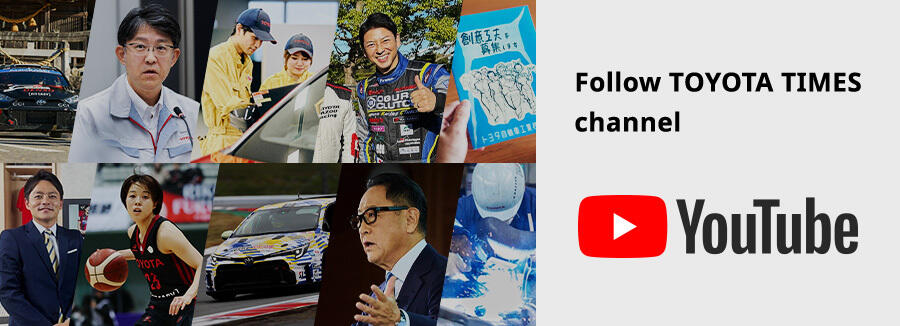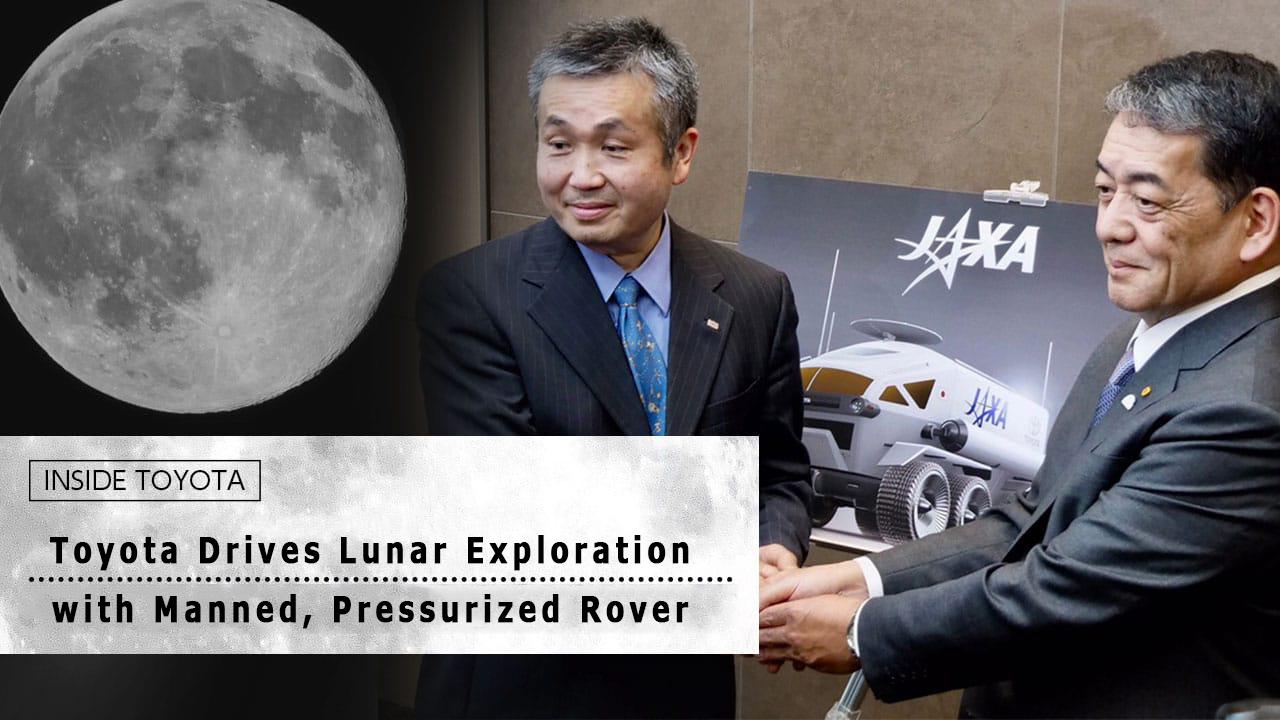
Toyota's Shigeki Terashi joins an international space symposium in Tokyo, speaking and discussing how every engineer thinks and dreams about going to the sixth continent -- the Moon.


"Every engineer thinks and dreams about going to the sixth continent"
Cruise on the Moon
This year, 2019, marks 50 years since Captain Armstrong of the Apollo 11 mission took mankind’s first steps on the surface of the moon. Now once again, a space exploration program with an international framework aiming for the moon and Mars is being actively discussed around the world. Japan is no exception. At an international space symposium in Tokyo this past week on March 12th, a large number of professionals from a variety of related industries and research institutions were in attendance to hear about and discuss the latest trends, movements, and approaches to the challenges that need to be overcome in space exploration.
Among the sessions, in the evening session entitled “Lunar surface activities by collective efforts across the nation”, an overview of a manned, pressurized rover that has been under discussion behind the scenes between the Japan Aerospace Exploration Agency (JAXA) and Toyota was announced.
First, Dr. Koichi Wakata, JAXA Vice President and Astronaut, took the stage and introduced JAXA’s vision for an international space exploration program aiming to expand the arena of mankind and the creation of intellectual properties. Wakata, while emphasizing the importance of cooperation between the scientific and industrial communities, further explained that in addition to working under an international collaboration scheme, it is also necessary to work collectively across the nation of Japan as “Team Japan”.
Critical within the framework are manned, pressurized rover missions, with the timing of the missions to be the early 2030s. The rover is anticipated to be a wheeled vehicle capable of travel across the surface of the moon and capable of maintaining atmospheric pressure suitable for humans to spend time inside without the need to wear a space suit. As he wrapped up his presentation of this first-of-its-kind series of missions, Mr. Wakata introduced JAXA’s new partner and team member for the rover, Toyota Motor Corporation.
Upon the conclusion of Dr. Wakata’s presentation, Toyota Executive Vice President Shigeki Terashi was invited to the stage where he gave a presentation entitled “Toyota Contributes to International Space Exploration”. The following is excerpted from that presentation.
Engineer's Dream
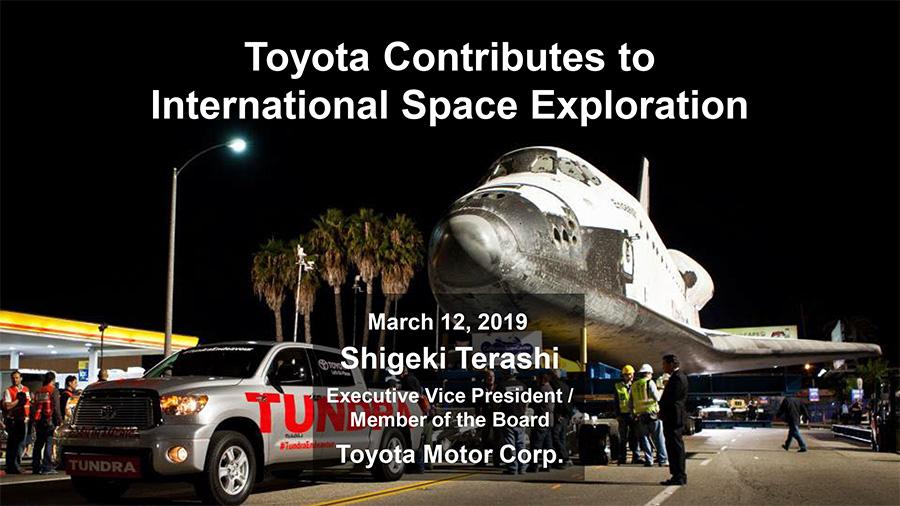
Hello, my name is Shigeki Terashi of Toyota Motor Corporation. Normally, my conversations are about limited to cars, but today I am here at the JAXA space symposium, so I feel out of my world and a bit nervous.
Let me start by introducing Toyota’s first encounter with a project related to space as seen in this photograph. This photograph is from 2012 when we used one of our vehicles to help transport the decommissioned space shuttle Endeavour from the Los Angeles International Airport to the California Science Center. While it was only used for just a small part of its final journey, we were extremely honored to provide one of our Texas-built Toyota Tundra pickup trucks.
Since our founding, we have had the philosophy that we should do all we can to be useful to humanity and society. Now, on this occasion, it is a true honor again to be asked to participate in a project [with JAXA] that aims to expand the arena of human activities to the surface of the moon and the requirements of that harsh environment – certainly a dream come true for any engineer, I think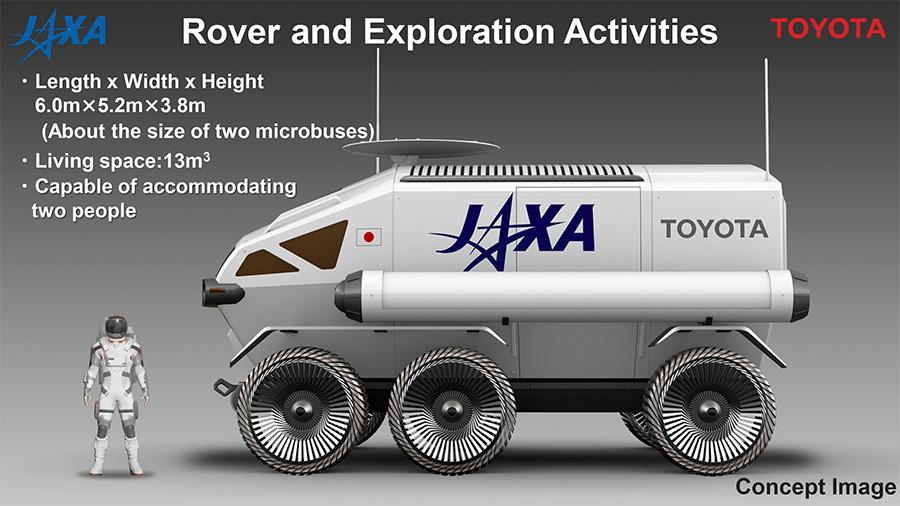
Currently, based on the various parameters we received from JAXA, and while only at a hypothetical stage, please allow me to share and introduce a few of the rover’s features. This is a conceptual image. Because ultimately there will be a various number of additional/changing parameters that might arise, this is subject to change. Sometimes we hear that Toyota’s vehicle designs can be a bit boring; however, I think that this type of design should be reflected in the next Land Cruiser. (Laughs)
To realize the series of lunar surface exploration missions [outlined by Dr. Wakata], there are a number of things that are necessary, starting with rockets and a gateway. Among these preparations, the part that we at Toyota can make the greatest contribution to is, of course, in making a vehicle to transport people.
To make the lunar rover, we have been asked to consider the following parameters:
- The vehicle must be able to travel on the moon’s surface for up to 6 weeks
- The interior must be designed to allow the astronauts to remove their space suits and live
- The space inside needs to be able to provide just under about 13 m3 of living space
- The exterior should be slightly larger than “the size of two microbuses”
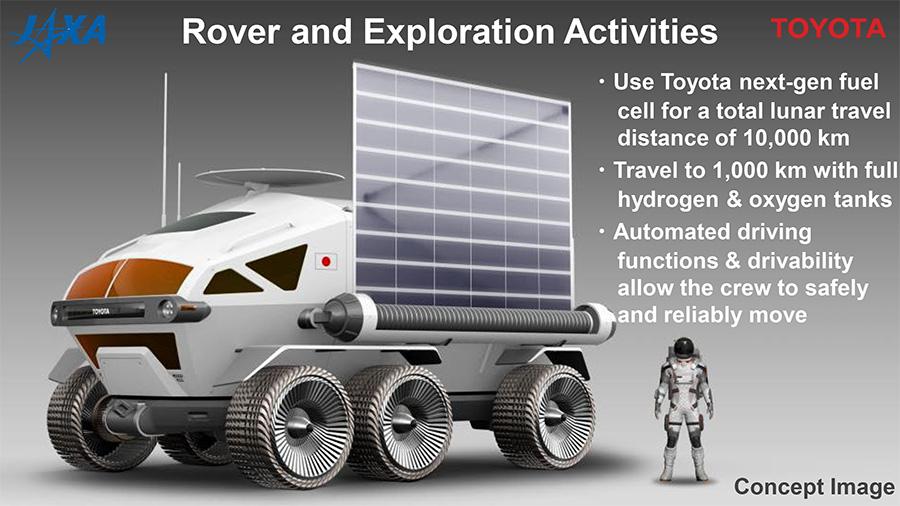
Overall, the initial mission is planned to run a total 10,000 km over 42 days. In order to secure the amount of energy needed to travel, Toyota plans to equip the vehicle with its next-generation fuel cell. We plan to make the rover capable of traveling up to 1,000 km on one fill of the hydrogen tank. We understand that daytime on the moon lasts for two weeks and that nighttime also lasts for two weeks, so the vehicle will need to generate electricity using solar photovoltaic panels and electricity will also need to be stored to use in the operation of other electronic devices outside of vehicle movement. Also, to help the crew be able to safely arrive at their destinations, the vehicle will need to offer driving performance and automated driving functions.
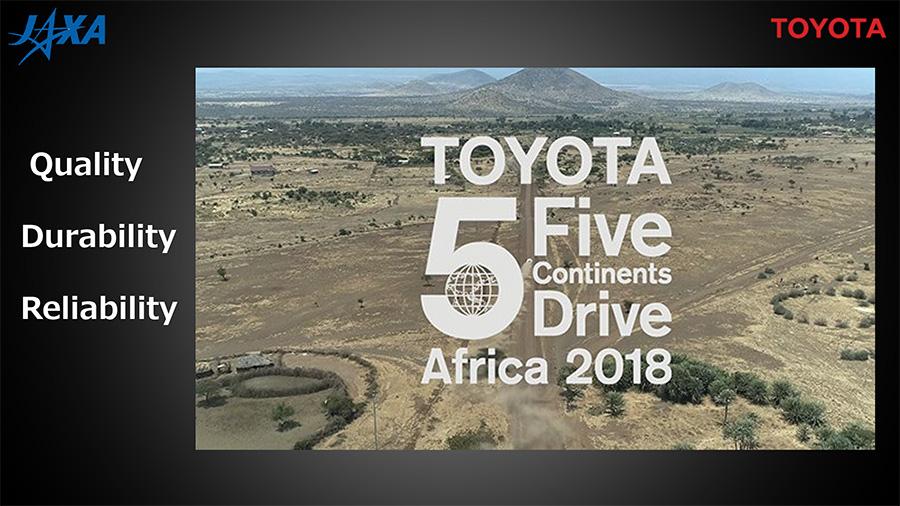
This is a video showing our “5 Continents Drive Project”. Toyota provides vehicles for the use of our customers all around the world. Starting from 2014, we undertook the goal to visit all five continents all over again. Our philosophy is that by knowing the types of roads that exist around the world and how those roads affect people, we should have people who have experienced that for themselves to build ever better cars. Some customers travel for hours in areas where there are no roads, where if a vehicle gets stuck or breaks down it can be a matter of life or death.
We continue to labor daily so that customers like these will choose the quality, durability, and reliability that our vehicles are known for. While the environments on earth and the surface of the moon are completely different, we would like to maintain that same reputation for quality, durability, and reliability as we aim to fulfill our role in the development of the lunar rover.

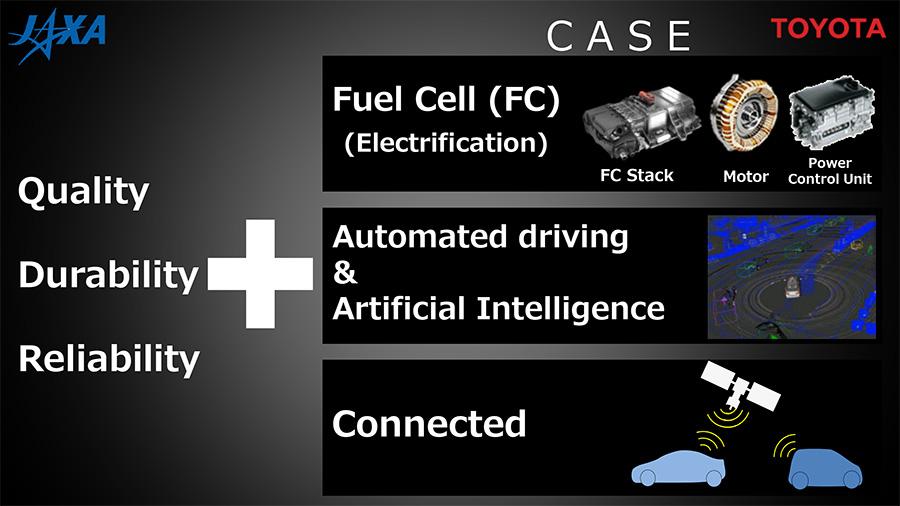
In addition to quality, durability, and reliability, recently, there is an acronym being used – “CASE”. If we are comparing so-called “real” technology to the traditional terms of quality, durability, and reliability, then we can compare the individual parts of CASE to “virtual” technology, such as automated driving, artificial intelligence, and connected, etc. For travel on the surface of the moon, we will need the collective strengths of both “real” and “virtual” technologies. This is because of the even harsher environmental conditions that exist on the moon versus those found on Earth. We want to do all we can to satisfy the demands of this project by further forging these collective strengths.
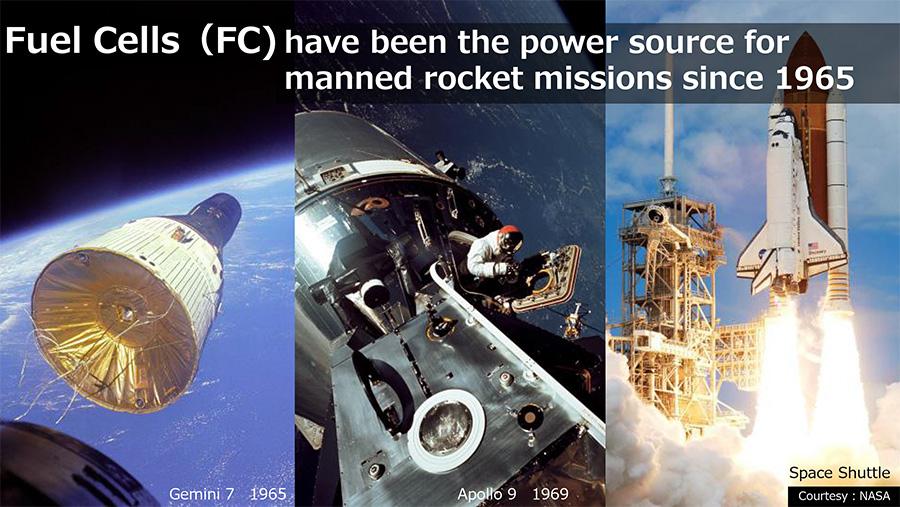
From here, please allow me to share some additional information about the fuel cell technology that Toyota will use to contribute to this project. Fuel cell technology is not new. In fact, hydrogen fuel cells have been used as an energy source for space missions since planning the first Gemini mission in 1965, through the Apollo and space shuttle missions.
Let me show you how fuel cells operate. Maybe some of you know already, but fuel cells operate by generating electricity from the chemical reaction caused from the combination of hydrogen and oxygen. The product of this reaction is water. Because both hydrogen and oxygen are gases, if you put them in a tank, they can be stored for a long period of time and can be transported.
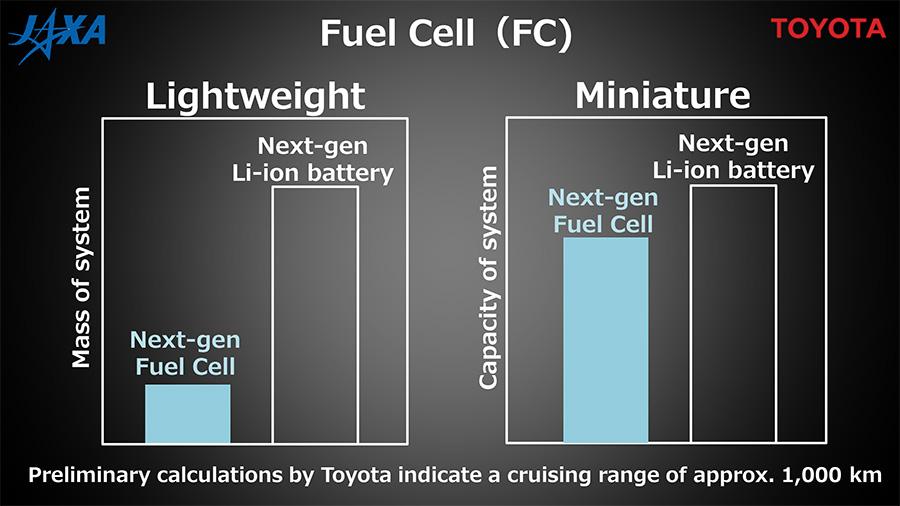
So how do fuel cells compare to lithium-ion batteries? This was something that we considered from various angles. In general [fuel cells] have the characteristics of being lighter and more compact [than lithium-ion batteries]. As our engineers considered the needs of this mission, they calculated the amount of energy that would be sufficient to secure the driving range required, and found that fuel cells, at approximately one-fifth the mass of lithium-ion batteries and about 20 percent smaller in terms of volume, were the best choice.
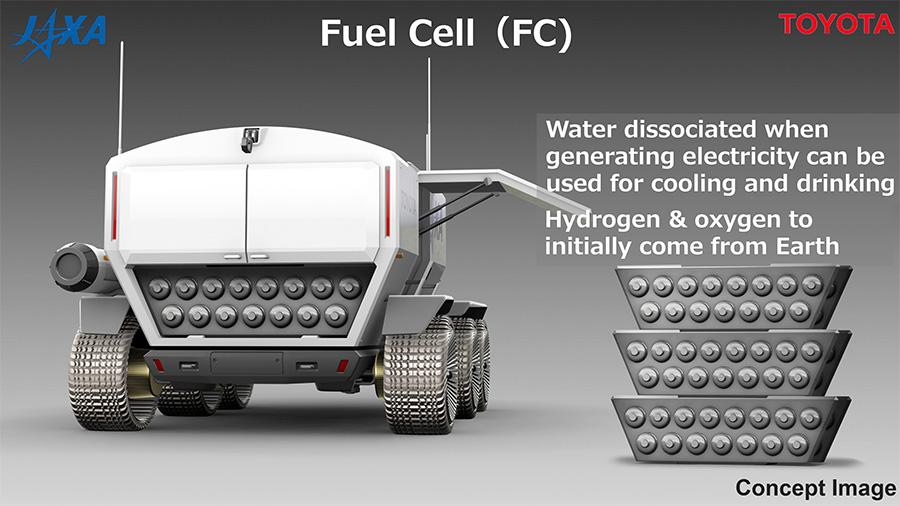
For the initial mission, the hydrogen and oxygen that will be used as fuel will be transported from the Earth. By exchanging tanks, the rover should be able to operate for a long time. The water that results as the product from the generation of electricity can be re-used as either a coolant or as drinking water. For these and other reasons, we believe fuel cells to be the most suitable source of energy for this mission.
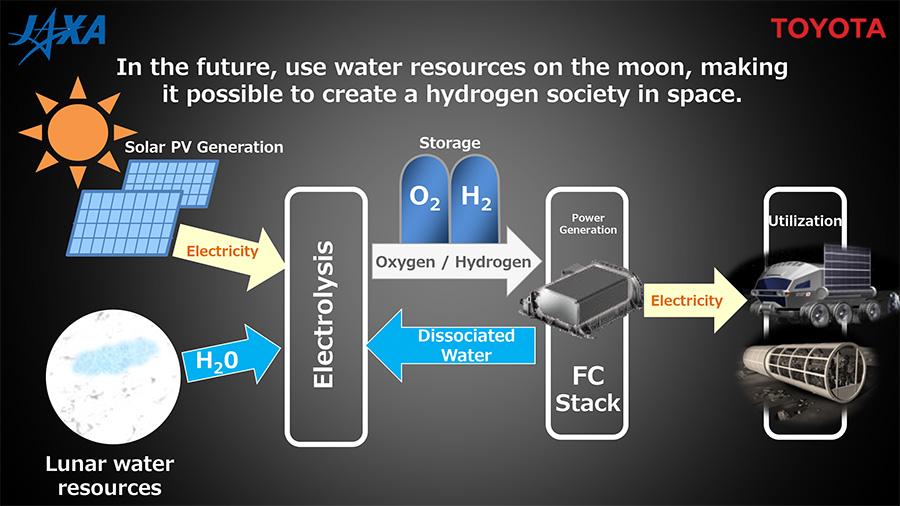
Furthermore, if, for example, the lunar surface exploration mission yields a source of lunar water, and if that water can be utilized, then it might offer a secure supply of energy for human activities in space. Solar photovoltaic panels could be used for electrolysis, splitting the hydrogen and oxygen to be stored as a fuel, then using that to generate electricity, with the byproduct of water again. That water could be used for living or even as a source of electricity.
We at Toyota also believe that the water could be used to create a hydrogen society. From this viewpoint as well, we feel that this might be a mission of great significance and would like to contribute. For Toyota, in order to realize a sustainable mobility society, we believe that hydrogen and fuel cells are indispensable and we are working to increase its use more broadly.
We would like for our fuel cell technology that we have cultivated to be used not only in products that we offer, but to be used in a host of mobility applications. We would like to coordinate and collaborate together with our many stakeholders using this technology.
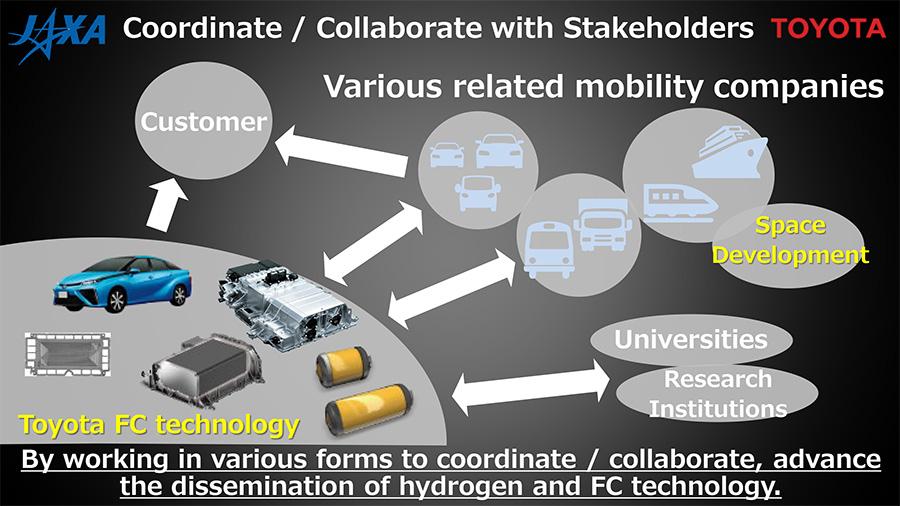
Space exploration is the dojo that tests even the highest level of technological strength, and we must do all we can to ensure the safe return of all members of the crew from this challenging mission. On this occasion, we are ready to challenge ourselves as we accept the honor of becoming one of the members of “Team Japan” under the strong leadership of JAXA.
Thank you
Following the presentation by Executive Vice President Terashi, a talk session was held together with Dr. Wakata. Below are select portions from their discussion.
"Toyota’s connections with space are old news?!”
- Dr. Wakata:
-
Well then, let’s talk about this photograph.

- Dr. Wakata:
-
That is splendid. I saw [the Toyota Tundra towing the space shuttle] on TV and it brought back a flood of memories. Speaking of Space Shuttle Endeavor, for Japan, we did have two astronauts, Morii and Doi, on that popular spacecraft.
I also had the chance to ride in the space shuttle twice: once in 1998 and again in 2009. The first time I flew, and I introduced this in the session just prior to this, it was used to capture an experimental observation satellite, and the same space shuttle was used upon my return as well. Because it was something that we astronauts were especially deeply associated with, it was a really important mission [for Toyota] to carry [the shuttle], and when I saw that it was a Japanese automaker that was pulling the Endeavor, I remember feeling extremely proud to be Japanese.
Terashi: It was mentioned that this was the first project that Toyota had ever done related to space exploration, but, in fact, Dr. Wakata brought Toyota’s robot astronaut “Kirobo” with him into space as part of the hope robot project… - Terashi:
-
It was mentioned that this was the first project that Toyota had ever done related to space exploration, but, in fact, Dr. Wakata brought Toyota’s robot astronaut “Kirobo” with him into space as part of the hope robot project…

- Dr. Wakata:
-
That’s true. In 2014, when I was assigned as the commander of the International Space Station, I took the opportunity to use it to talk to Kirobo. It was a valuable and first-of-its-kind experience for an astronaut to speak with a robot astronaut in space. I felt then as well that Toyota was destined to do something with space.
- Terashi:
-
The [rover] project is not the first time that we’ve discussed things. When we were approached for this project, we had already been working on a space concept. Some of our younger team members within Toyota said that they wanted to do something in space. We started with talking [with JAXA] with a small team, but as we exchanged information, we received the idea of the project discussed today. Actually, we started looking at possible collaboration from last year…
As we looked at the members of this project and compared them to our other employees, we could see that they were excited about their work and really having a good time. As we think about how we’ll need to expand the team on this project, if we were to call for people to submit their names to work on this project, I’m sure we’d be overwhelmed with the response. In fact, it gives me a bit of a headache just thinking about how to go about making the team. - Dr. Wakata:
-
Thank you. The team members here at JAXA are also proud to have the prospect of working together with Toyota’s staff, people known for their for work on high quality and reliable products.
In the morning session, there was mention and a video of the successful touchdown of the Hayabusa2 explorer spacecraft on the Ryugu asteroid. This also made me proud as a Japanese. Hayabusa 2 was an example of unmanned technology, while the ISS module nicknamed “Kibo” (hope) and the HII Transfer Vehicle (HTV) are examples of manned space activities that have cultivated various technologies and reliability – these unmanned space technologies and manned exploration can be combined. By combining them, the next target is the moon, but can be expanded to Mars beyond that.
Speaking on the JAXA vision, we are depicting it based on the image of the 2040s, but we believe the pressurized rover to have utmost importance among that vision. We’ve heard that Toyota already has a long-range vision, decades ahead for what you a challenging yourselves on… - Terashi:
-
Yes, we especially have our “Environmental Challenge 2050” goals, and now we have this new ten-year [pressurized rover] goal for 2029. But ten years in the future really isn’t all that far away if you think about it. If you compare to the development cycle for a car, which is about four years, and think about the fact that this is a brand-new area for Toyota, ten years may feel like it is not enough time. We will need to do various evaluations; however, we will use this as an opportunity to work together to increase the speed of our development.
- Dr. Wakata:
-
I failed to introduce this earlier, but while we envision this mission being in a scenario after 2029, the lunar rover that we have introduced here is intended to be a point of contact that JAXA and Toyota will have together.
Manned space activities = quality and reliability, and these are critical to a manned mission to the moon in terms of allowing the people to go and return in the best conditions possible. I can’t emphasize enough the importance of having a high level of safety and reliability. This is possibly the most important demand that we have.
Also, the mission will meet with environmental conditions including radiation and temperature challenges as well as the fact that the mission will require driving over thousands of kilometers on the harsh physical surface of the moon. I believe that these are extremely challenging objectives but I am confident that Toyota, with its advanced fuel cell technology to use energy efficiently and other overall technology, will rise to meet our expectations. I think that we can work together across the nation of Japan to make it a success.

The potential of hydrogen, defining “minus emissions”
- Terashi:
-
I just mentioned our “5 Continents Drive Project”, where we were able to learn a lot of valuable insights, but perhaps this “6th Continent” [of the moon’s surface] will have the most stringent requirements that we will need to focus our efforts on. For the [lunar rover] project performance requirements already discussed, there are three main hypothetical points.
First, hydrogen and fuel cell technology. In order for [the rover] to be able to travel over long distances and support long periods of nighttime, we will need to further hone our hydrogen technology to be used as a source of energy.
Second, there are no paved roads, so we’ll need to know what the surface of the moon is like versus a regular road surface. Because there are ups and downs, [the rover] will need to be reliable enough to handle those types of situations.
Finally, there is a need for automated driving functions. Currently, if we wanted to perform automated driving, we have to attach a number of apparatuses, such as sensors, cameras, LiDAR, etc. However, because of the amount of time it would take to send and receive a signal to the earth, the time difference for automated driving could be lethal. Therefore, the vehicle will need to be equipped with a self-driving function that allows it to travel autonomously.
I think that may possibly be one of the most challenging aspects to do on the surface of the moon. However, as we fix our gaze on the mission ten years from now, we have a lot of milestones to get us there, and we will try with all our might to make steady efforts [to get there].
As just mentioned, we think of this as an opportunity to demonstrate a hydrogen society, and the lunar rover that we are currently working on will start by bringing the hydrogen and oxygen it will need as fuel from Earth; however, if it becomes possible to harvest water from the moon, then it would be really great to setup some type of hydrogen refueling station there. - Dr. Wakata:
-
Absolutely. Each country is aiming for that, and in the early 2020s, each country is planning on doing missions to explore the moon’s polar regions to see if there are any usable water resources – Japan is also promoting a similar plan. After that, in the latter half of the 2020s, we anticipate further study, including experiments to see how we might separate the hydrogen and oxygen from any discovered water resources.
Therefore, just as Mr. Terashi has explained, although initially we will need to bring the hydrogen and oxygen for the fuel cells, in the future we can hopefully use hydrogen harvested from the water resources on the surface of the moon to provide the energy needed to live and for transportation. - Terashi:
-
In other words, the surface of the moon may have a hydrogen society even faster than what is happening here on Earth.
- Dr. Wakata:
-
Yes, that is correct. Because water and ice are extremely precious resources, it is appropriate to say that for sustained activities that include mobility and recycling systems to help us reach our targets for the moon and eventually our goal for a manned space mission to Mars, I think a mobility system is necessary.
In order to do that, it will probably become necessary for all related fields within Japan, including businesses, academia, R&D institutions, working on hydrogen technology to gather their expertise together. My understanding is that Toyota, for example, is already exerting a lot of effort to expand the use of hydrogen on Earth. - Terashi:
-
Recently we often are asked which are better, battery electric vehicles (BEV) or fuel cell electric vehicles (FCEV). Because there continues to be some misunderstanding, I’ll explain it again here. Basically, a BEV uses an electric motor to propel the vehicle, a battery as the energy supply, and a power control unit to control the energy output. It is a set with those three components.
The vehicle must store electricity that it receives from an external source, so it needs a lot of batteries. Fuel cells, on the other hand, in addition to having the same three core components add the ability to generate electricity needed to propel the vehicle from its onboard hydrogen fuel. While both types are electric vehicles, the source of that electricity is not the only thing that is different. However, did you know that FCEVs actually have another ability to clean the air, Dr. Wakata? - Dr. Wakata:
-
I have only heard a little bit about that.
- Terashi:
-
Actually, as a MIRAI is being driven, it pulls in outside air and passes it through a filter to pull the oxygen it needs to combine with the hydrogen to run the vehicle, with the filter essentially cleaning the air during the process. Actually, the product of the reaction in the fuel cell is both water and air; however, of the air that is exhausted, because of the filtering function, particulate matter is largely reduced.
In other words, it functions as a sort of air purification system. If we use this function more and more, the nitrous oxide and sulfur oxide emitted by cars can potentially be removed from the air, leaving it clean. Therefore, hydrogen vehicles, being zero CO2 emission emitters, and I’m not sure if this is the right terminology, could be considered “Minus Emissions” because of their ability to remove air pollutants. In the next generation MIRAI, we would like to make it the type of car that not only reduces particulate matter by 2.5, but one that can draw out both nitrous and sulfur oxides from the air. We’d like to see broader adopted use of this technology, not only for automobiles, but as a source of energy for a variety of forms of mobility products. - Dr. Wakata:
-
I think this is also a good opportunity for us to hear about your experience as a Japanese Commander of the International Space Station. Can you tell us what is most important to astronauts?

“Efforts should be made for the Home Planet”
- Dr. Wakata:
-
It was just four or five years ago since I finished my turn at astronaut command. I think it is important to balance the needs of competition and cooperation when it comes to space exploration. More than anything, the most important thing is to all be working as a team in one direction.
Among the crew were people from Russia, the United States, Europe, and Canada. With this type of a team, in order to produce the maximum degree of results, it is really critical to have a feeling of harmony. This is especially true in a closed environment. This would also be true and teamwork would be important for missions to the moon and Mars.
Mr. Terashi, you have also been a project manager for things like the Crown car in Japan, so I think you can also understand the essential nature of teamwork when it comes to the development of automobiles. - Terashi:
-
A vehicle is composed of some 30,000 parts and components. However, about 70 percent of that is done by suppliers, brought in from the outside, and in-house we do about 30 percent. To make a car, you first have to cooperate with many people.
For [the rover] project, we are asking Bridgestone to teach us things about tires, and will work with others like this to make [the rover]. Up to now, we have been known as our “home town” or “home country” identities; however, as we look at ourselves from the moon, we are one planet. Therefore, do we call it just “home planet”? If we look at it that way, it is even more important that we all cooperate. - Dr. Wakata:
-
I feel exactly the same way. Talking about teamwork, the theme for today has been “Team Japan”, but the mindset of “home planet” is something that is also important and necessary. I think we need to expand and find partners across the entire globe. While we are talking about collective efforts across the nation of Japan, we are also looking at how what we do here contributes to the international community – something that is definitely necessary, in my opinion.

